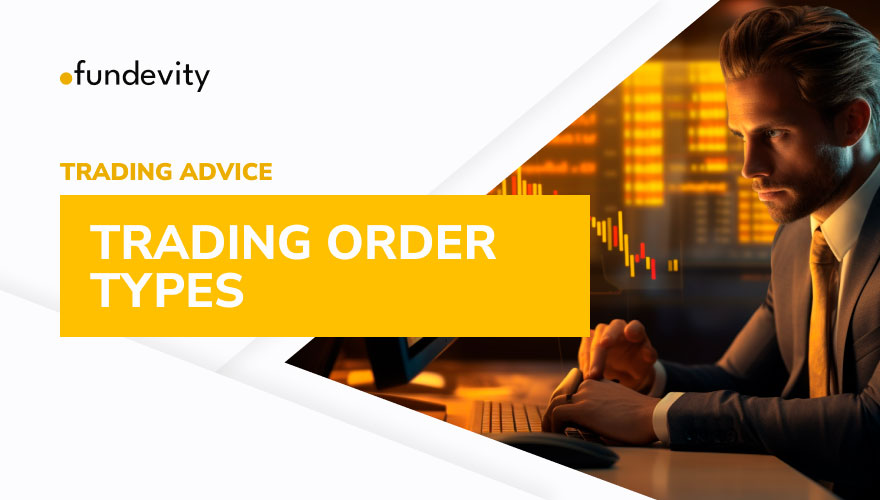Trading Order Types – All You Need to Know

Understanding different trading order types is essential if you’re new to trading or looking to expand your knowledge. In this blog post, we’ll dive deep into three common order types – market orders, stop orders, and limit orders. We will be giving you all the knowledge you need to become a confident trader.
Let’s begin and see what you can learn.
What Are Trading Orders?
Trading orders are essentially instructions traders give to their brokers or trading platforms to execute buy or sell transactions on their behalf. These orders play a crucial role in the trading world as they dictate how and when trades will be executed. They provide structure and organization, ensuring that trades are carried out efficiently and effectively.
Various types of trading orders are available, each serving different purposes and catering to different trading strategies. By understanding these order types, traders can maximize their potential for success in the market.
Different Types of Orders
Each order serves a specific purpose and can greatly impact your trading strategy. Let’s take a closer look at some of the most common order types.
- Market Order: This is the simplest type of order, where you buy or sell an asset at the current market price. It guarantees execution but does not guarantee a specific price.
- Limit Order: With a limit order, you can set a specific price for buying or selling an asset. The trade will only be executed if the market reaches that price or better.
- Stop Order: A stop order helps protect against potential losses by triggering a sale when the market falls below a certain predetermined level (stop loss). On the other hand, it can also be used to enter into trades when prices rise above a specified level (stop entry).
Understanding these different types of orders will give you more control over your trades and help you make informed decisions based on your trading strategy and risk tolerance.
Market Order
Market order is one of the most common types of trading orders. It is a simple way to buy or sell security at the prevailing market price. When you place a market order, you tell your broker to execute the trade immediately at any available price.
The advantage of using a market order is that it guarantees your trade will be executed quickly. This can be particularly useful when you want to enter or exit a position as soon as possible, regardless of the price.
However, there are some risks associated with market orders. Since they prioritize speed over price, there’s a possibility that you may not get the exact price you were expecting. In fast-moving markets with high volatility, the difference between the quoted price and actual execution can vary significantly.
Stop Order
A stop order is a commonly used trading order that helps traders manage their risk and protect their profits. It’s the order type placed to buy or sell an asset once it reaches a certain price level, known as the stop price.
When placing a stop order, you specify both the stop and limit prices. The stop price triggers the execution of the trade, while the limit price determines the maximum or minimum acceptable price at which you are willing to execute your trade.
Stop orders can be either buy-stop orders or sell-stop orders. A buy-stop order is placed above the current market price with the intention of buying if and when the market reaches that higher level. On the other hand, a sell-stop order is placed below the current market price to sell if and when prices drop to that lower level.
Limit Order
A limit order is used in financial trading to specify the maximum price at which a buyer is willing to purchase a security or the minimum price at which a seller is willing to sell a security.
There are two main types of limit orders:
- Buy-limit Order: This order is placed at a price lower than the current market price. It specifies the maximum price the buyer is willing to pay for the security. If the market price reaches or falls below the specified limit price, the order is triggered, and the trade is executed at the limit price or a better price if available.
- Sell-limit Order: This order is placed at a price higher than the current market price. It specifies the minimum price the seller is willing to accept for security. If the market price reaches or exceeds the specified limit price, the order is triggered, and the trade is executed at the limit price or a better price if available.
Traders and investors often use limit orders to achieve specific price targets or ensure they enter or exit a position at a favorable price level.
Conclusion
To wrap things up, trading order types are vital tools in the trader’s toolbox. Market orders offer speed but can mean price uncertainty. Stop orders act as shields, preventing significant losses. And limit orders give control over prices, though they might not always trigger.
Choosing the proper order type depends on your goals and risk tolerance. Using these tools wisely allows traders to seize opportunities, manage risks, and make more informed decisions. Remember, understanding these order types is a key step toward becoming a successful trader in finance.


